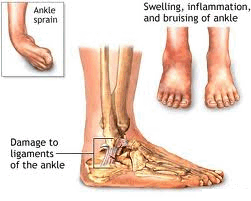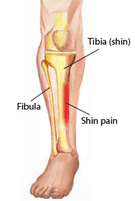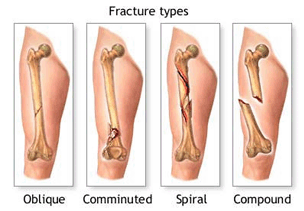The Five Most Common Sports Injuries
While playing sports can be very beneficial to your health, all sports carry some risk of injury. The severity of these injuries can range from minor to very serious, with some more severe injuries requiring surgery to fully correct. Injury can result from poor training practices, improper equipment, flawed techniques, or simply by accident. Improper conditioning, such as insufficent warm-up or stretching of muscles before exercise, may also cause injury. Five of the most common sports-related injuries are:
Sprains and Strains
Sprains and strains are the most common type of sports injury, and can occur during almost any type of physical activity. Both types of injury may cause symptoms such as swelling, inflammation, bruising, or pain with use.
Sprains occur when a ligament (band of connective tissue that attaches bones to other bones) tears or overstretches. Sprains may range from minor, where a ligament is slightly torn or overstretched, to severe tears where the ligament is severed completely. Sprains are most common in the wrists, ankles, and knees.
Strains, on the other hand, are concerned with the actual muscle or the tendons that attach them to bone. Strains may also be referred to as pulled muscles, and occur when the fibers within a muscle or tendon stretch too far or tear. Like sprains, strains may range in severity.
Sprains occur when a ligament (band of connective tissue that attaches bones to other bones) tears or overstretches. Sprains may range from minor, where a ligament is slightly torn or overstretched, to severe tears where the ligament is severed completely. Sprains are most common in the wrists, ankles, and knees.
Strains, on the other hand, are concerned with the actual muscle or the tendons that attach them to bone. Strains may also be referred to as pulled muscles, and occur when the fibers within a muscle or tendon stretch too far or tear. Like sprains, strains may range in severity.

Knee Injuries
Every year, over five million people visit orthopedic surgeons for knee-related injuries. Mild knee injuries include iliotibial (IT) band syndrome, runner’s knee (tenderness or pain near the front of the knee cap), or tendonitis (degeneration or inflammation within a tendon). Severe injuries can involve damage or bruising to cartilage or ligaments that provide stability to the knee. The four major ligaments in the knee that are commonly injured are the posterior cruciate ligament (PCL), the medial collateral ligament (MCL), anterior cruciate ligament (ACL), and the lateral collateral ligament (LCL).
Shin Splints

When pain along the shin bone (tibia) occurs, it is known as shin splint. This pain usually occurs at the front outside portion of the lower leg, but can also occur in the front portions of the foot and
ankle (anterior shin splints) or where the bone meets the calf muscles at the inner edge
of the bone (medial shin splints). Shin splints are common with runners, especially those that tend to run on hard surfaces such as pavement. Failing to warm up or stretch, improper running
techniques, running in shoes that lack proper support, or having “flat feet” can contribute to shin splints.
Fractures
Commonly referred to as broken bones, fractures are a fairly common sports injury that occur when the solid bone is damaged. This may occur due to a specific injury, such as a fall. Such instances, where the fracture is tied to a one-time injury, are known as acute fractures. Depending on the method of injury, different types of acute fractures may occur, including oblique, comminuted, spiral, and compound fractures.
It is also possible for repeated stress on a bone over a prolonged period of time to cause tiny cracks in the bone, known as stress fractures. These injuries typically occur due to repetitive stresses to the bone caused by activites such as long-distance running or excessive jumping. Most fractures are classified as emergencies, and may require surgery to completely repair.
It is also possible for repeated stress on a bone over a prolonged period of time to cause tiny cracks in the bone, known as stress fractures. These injuries typically occur due to repetitive stresses to the bone caused by activites such as long-distance running or excessive jumping. Most fractures are classified as emergencies, and may require surgery to completely repair.

Dislocations
Dislocations, also known as luxations, occur when excessive force pushes the bones in a joint out of alignment. Contact sports such as football or activities such as agressive stretching or falling can cause dislocations. While it may be possible for an untrained person to "pop" the dislocated bones back into place, improper technique can lead to severe damage to the connective tissue surrounding the joint. As a result, dislocations are typically considered an emergency and will usually require treatment by a medical professional to correct. The most common joints that may become dislocated are the fingers and hand, as well as the shoulder. Elbows, knees, and hips can be dislocated but are less common.